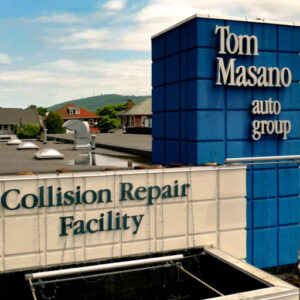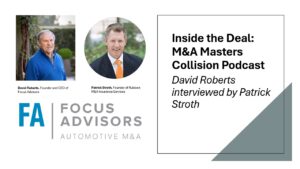For the last 5 years, Focus Advisors and other industry observers have been reporting on a continual increase in Consolidator acquisitions. Looking back at the year 2016, it appears the total number of MSO and single shops acquired by the Big Four Consolidators has peaked. From 2012 through the end of 2015, the number of shops acquired by the Big Four accelerated year over year over year even as the percentage growth rate slowed. But in 2016 the total number of new shops acquired or opened slowed dramatically – down by 40%! In 2017 the decline seems to be even greater.
This 18 month slowdown has been further reflected in a reduction in purchase prices for MSO and single shops acquisitions, which illustrates a change in strategy by the four large Consolidators that is impacting smaller MSOs and single shop exit opportunities.
Observations:
- Total acquisitions of MSOs by the Big Four are declining
- Consolidator growth trends are bifurcating into two streams:
- Fewer MSO acquisitions and more single shop acquisitions
- More development of Brownfield and Greenfield shops
- The difference between seller expectations and buyer bids is widening
- The pool of single shop sellers is growing rapidly
- Smaller MSOs and Private Equity firms are increasing their acquisition activities, albeit at very modest values
At FOCUS Automotive, we track the acquisition activities of the most visible acquirers as well as the openings of their Brownfield and Greenfield facilities. Over the past three years, FOCUS has been a key player in the collision repair industry and represented multiple collision repair clients, from 10 shop MSOs to single shops, in their quest to maximize shareholder value at the time of their business sale. Our clients have drawn interest from multiple bidders including each of the Big Four Consolidators, private equity firms, regional MSOs and high net worth individuals. With this breadth of experience, we have gained valuable insights into the perceived and realized business values and the actual structures of offers and actual closed transactions.
A Review of Consolidator Growth in 2016 through May 2017
- Both Gerber and Caliber have continued to grow more aggressively recently, with Caliber continuing to lead in the number of acquisitions and openings.
- ABRA acquired or opened very few shops in 2016, and so far in 2017 shows few signs of reengaging in the acquisition landscape.
- Service King slowed its pace in 2016 and continues to move selectively in 2017
- The number of MSO shop acquisitions is declining significantly compared to prior years.
Consolidator Shops in US Through May 2017
| End of 2013 | End of 2014 | End of 2015 | End of 2016 | Through May 2017 | |
| Caliber | 158 | 232 | 358 | 479 | 499 |
| ABRA | 132 | 205 | 335 | 342 | 343 |
| Service King | 104 | 211 | 276 | 311 | 324 |
| Boyd | 220 | 282 | 311 | 362 | 368 |
| Total | 614 | 930 | 1280 | 1494 | 1534 |
| Total added | 316 | 360 | 214 | 40 | |
| YR/YR Growth % | 51% | 39% | 17% | 6% |
Conclusion: The Acquisition Tide Is Receding
Both the total number of MSO transactions and the closed transaction values are declining in the US market. Both Gerber and Caliber have continued to grow more aggressively with Caliber maintaining an annual growth rate in excess of 25%. And both continue to grow with MSO acquisitions, just fewer of them over the past 18 months.
Caliber and Gerber/Boyd MSO Acquisitions in 2016 through May 2017
| Company | Acquirer | Acquisition Date | Locations |
| Craigs Collision/B and B Auto Body | Caliber Collision Center | 3/4/2016 | 7 |
| J and M Body Shops | Gerber/Boyd Group | 3/21/2016 | 5 |
| Specialty Paint and Body Works | Caliber Collision Center | 5/15/2016 | 2 |
| Collision Care Auto Body Centers | Caliber Collision Center | 6/6/2016 | 7 |
| Collision Care Group Carstar (King) | Gerber/Boyd Group | 8/2/2016 | 9 |
| Adrian’s Collision Centers | Gerber/Boyd Group | 11/9/2016 | 5 |
| Roger Beasley Collision Centers | Caliber Collision Center | 12/5/2016 | 2 |
| Factory Spec Collision | Gerber/Boyd Group | 12/12/2016 | 3 |
| Brighton Collision Center | Gerber/Boyd Group | 1/13/2017 | 5 |
| Conner Brothers Collision Centers | Caliber Collision Center | 1/19/2017 | 4 |
| True Form Collision Repair | Gerber/Boyd Group | 3/21/2017 | 2 |
Growth in Brownfield and Greenfield Development
The slowdown in acquisitions might lead one to believe that the Consolidators are content to growing at a slower pace for now and the market is stabilizing, but this is simply not the case! In fact, the slowdown in acquisitions has been replaced by an even more disruptive strategy: Brownfield and Greenfield development (creating new locations where they didn’t exist before).
During the last 17 months, Caliber has opened more than 50 Brownfield and Greenfield locations. The most dramatic example of this change in Caliber’s growth strategy was the opening of 6 locations in the Jacksonville market in the first three months of 2017 – all Brownfield and Greenfield locations.
Gerber has similarly begun to shift some of its resources into development of Brownfield and Greenfield sites. While both ABRA and Service King have executed on fewer MSO transactions during this same period, each has begun identifying and developing Brownfield and Greenfield sites as well.
This shift among all of the Big Four Consolidators reflects the higher Return on Investment (ROI) that acquirers realize when they can develop their own new shops rather than purchasing them. The offset to these higher ROIs is the lengthy lead time required to establish a Brownfield or Greenfield location and the cost and difficulty in staffing them with qualified technicians.
What Does Brownfield and Greenfield Development Really Mean for Single Shops and Small MSOs?
The strategy by the Big Four of acquiring shops as opposed to building their own from scratch has been healthy for operators seeking to exit the industry. It provided business owners an opportunity to achieve liquidity for the businesses they had founded and grown over a long period of time. While it didn’t appreciably reduce the total number of shops in a market, those shops became part of the portfolio of a much larger and well-capitalized owner and achieved more sales growth and stability. The downside was that as the new Consolidator owners gained additional DRPS in those locations, the remaining DRP shops had to share their referrals with another well-qualified provider.
The new trend of Brownfield and Greenfield development actually does the exact opposite. It adds new capacity to the market but this time in the hands of the Consolidators. When these new shops are granted DRP status, they further dilute the referral base among existing shops. In some markets, existing shops are being removed from DRPs as these new Brownfield and Greenfield shops are added. Existing shops are forced to divide up a reduced insurance referral stream among themselves with smaller, less well-capitalized ones losing the most market share.
Fewer acquisitions by the Big Four further reduces the acquisition demand for MSOs and single shops, reduces the number of potential buyers for any individual seller, reduces the prices paid, and increases the number of shops at a time when most would argue there already are too many collision repair centers in the market. All of this contributes to the likelihood that owners who are thinking about selling will have to either sell for less than they would like or won’t be able to sell at all.
Widening Spread Between Sellers’ Expectations and Buyers’ Bids
Sellers often think their businesses are worth more than buyers are willing to pay. Today, the same is true for both MSOs and for single shops.
In discussions with our clients and with many single shop and small MSO owners thinking of selling, value expectations are in the 6-7x EBITDA and 50-75% of revenues. However, our review of closed transaction data indicates single shops are currently transacting at a wide range of values but in general between 35-55% of revenues with many being sold for asset value. EBITDA multiples of actual closed transactions are in the 4-6x range, with some considerably below that range. A review of private transactions from 2015 and earlier showed previous multiples in the 6-7x EBITDA range. Today’s sellers appear to be focused on values from prior years that are seldom being realized in the current environment.
However, we do see higher valuations for very large scale acquisitions such as Boyd’s acquisition of Canada’s largest MSO. Other potentially higher valuations include unpenetrated market entry platforms, smaller market dominant platforms and very specialized repairers such as high-end certified dealer driven shops. However, these transactions appear to be far less frequent than generic single shop or small MSO transactions.
Dealer Groups and Smaller Regional MSOs Continue to Make Acquisitions at Very Modest Values
In our survey of acquisitions by regional and city size MSOs, we are discovering a wide range of acquisition values, almost always below the prices offered by the Big Four Consolidators. Dealer groups and regional and local MSOs are often the successful buyers at lower valuations after sellers have failed to attract the interest of a Consolidator.
We have identified a number of dealer groups and multiple small MSOs that are effectively acquiring single shops. Using a combination of cash and financing techniques including paint company “prebates”, borrowing against existing real estate and seller financing, these local and multi-city MSOs have found significant growth opportunities.
While several dealer groups appear to be creating their own regional and national networks to enhance the attractiveness of their entire enterprise, many of the smaller MSOs are growing with the intention of eventually selling their larger entity to a Consolidator, another mega-regional MSO or private equity firm. For others, the long-term strategy is to continue growing and reaping the benefits of strong cash flow within their geographic regions.
The Pool of Single Shop Sellers is Growing Rapidly
Based on inbound calls and solicitations from single shop owners seeking representation as well as MSOs seeking acquisitions, we conclude that the number of single shop sellers is growing rapidly. We speculate that the reasons include:
- A more difficult DRP and certification environment requiring more capital and skills than many single shop operators are willing to invest or develop. While some are gaining support through affiliation or franchise relationships, many cannot economically or operationally meet these “Consolidator-like performance” arrangements.
- More direct outreach by Big Four Consolidators with specific and relatively formulaic terms that are surprisingly modest.
- Recognition by sellers that the opportunity to achieve a near-term liquidity event may be diminishing.
Why the Acquisition Tide is Receding
There are a number of reasons for the quickly decreasing opportunities for small MSOs and single shops to achieve liquidity events:
- Consolidators have fairly specific acquisition criteria including geographic considerations, IRR hurdles, how complementary new shops are to existing shops and planned Brownfield and Greenfield shops. Consolidators don’t need to be everywhere and specifically don’t want to be everywhere. They have penetration goals for markets where they already have platform operations and management teams in place.
For example, two years ago, Caliber bought B&R Auto Body in Charlotte with its 7 shops. Today that region of North and South Carolina has 13 Caliber shops, several of which were Greenfield or Brownfield shops. This strategy of entering a new market and buying a platform, adding single shops, then adding Brownfield and Greenfield shops has been successful for each of the other Consolidators as well.
- There are more sellers than ever before, for a whole host of reasons:
- Single shops that are losing market share see their futures are compromised.
- Technicians are migrating to higher volume competitors or are being recruited away with signing bonuses. Even busy single store and small to mid size MSOs are losing techs and service writers to the higher compensation arrangements being offered by Consolidators.
- Shops are losing referrals when they lose a DRP or when another shop is added to the local DRP network. Participation in performance-based referral programs often requires additional investments and connections to affiliations that many single shops are unwilling to make because of the speculative return or absolute cost required.
- More and more sellers are facing a buyers’ market, and no matter how attractive the seller’s operation the buyer knows he can buy something not quite as good or build a new shop for a lot less money and then recruit the writers and technicians to staff it.
Change Creates Other Opportunities – for Buyers and Sellers
Even as the Big Four have slowed their acquisition activities, regional and local MSOs, some of whom are private equity backed, have increased their acquisitions. As prices for single shops have decreased, well-organized and aggressive local or regional MSOs are stepping up their acquisitions – and finding lots of modestly priced opportunities.
If the Consolidator acquisition wave has passed a seller by, there is a secondary wave that represents another liquidity opportunity for sellers.
Third Choice – Franchises and Affiliations
As many single shops and small MSOs seek to enhance their ability to succeed, an increasing number are finding more secure homes among the leading franchisors and affiliations. Fix Auto, Carstar, MAACO each have different models as franchisors but each is growing their franchise base. Among their franchisees, there is a small but increasing number of franchise MSOs – some with as many as 33 shops.
Affiliation with an umbrella organization is another strategy many shops are choosing. Certified Collision Group, 1Collision Network and others are finding an increasing supply of affiliates seeking to improve their visibility and credibility with insurers, dealers and consumers by choosing to co-brand their shops and adhere to common standards that may be more rigorous than most shops – and bring with them DRP relationships.
Risks and Rewards in Non-Consolidator Transactions
For Buyers, the benefits may include:
- A relatively low-priced alternative compared to “Brownfield or Greenfield” expansion.
- A lower purchase price and better terms and conditions because primary buyers have passed on the business – or because the seller didn’t want to sell to a Consolidator.
- A portion of the financing may be provided by the sellers.
- Finding a diamond in the rough where buyer’s DRP relationships, operating staff and SOPs can be leveraged.
- Gaining entry to a smaller market or expanding into a contiguous market.
The risks to Buyers include:
- More difficult to conduct due diligence because of limited M&A experience and available time of buyer.
- Undisclosed liabilities may represent a significant portion of the acquirer’s net worth increasing the downside risk, although asset purchase agreements and hold-back clauses may mitigate this risk.
- Emotional drive to expand may overshadow financial risks in “opportunistic deals”.
For Sellers, the benefits may include:
- A secondary liquidity option if a sale to large regional or Consolidator isn’t possible.
- Continuity of employment for staff and family if negotiated as part of agreement.
- A liquidity opportunity even for businesses with serious challenges such as tax related or other legal liabilities.
- Opportunity to create continuing employment arrangements and favorable property lease.
The risks to Sellers are:
- The possibility of a failed closing is higher because smaller MSOs often have less capital or less access to capital and can’t fund the deal they’ve agreed to.
- The loss of staff during working towards closing a transaction because the acquirer potentially has less management and operating capabilities required to successfully operate the combined businesses.
Evaluating Alternatives: Sale or Continuing in the Business
Many sellers are disappointed in the offers they receive for their business, and they ask the question “Why should I sell for that price? I can make that much in continuing to run my business for the next four years – and then sell!”
The answer to this is……possibly.
Uncertainty about the Future
The math seems easy enough, but sellers often mislead themselves into believing that tomorrow will certainly be like yesterday. It will not!
- The collision repair industry is becoming more competitive, has a finite market of customers/insurers and will see a continuous downward shift in accident frequency and claims to repair due to ADAS technology.
- Margin pressures will continue to intensify due to rising costs of parts and labor with reimbursement pressure from insurers continuing.
- Additional investment in new equipment, upgrading staff and training to comply with new DRP demands come out of that same cashflow.
- Eventually ADAS over the next five years and eventually semi and fully autonomous vehicles will continue to change the operating economics and the liquidity opportunities for all collision repairers.
- Losing a DRP or a painter or a group of technicians can quickly take a toll.
- And finally, the owner has to continue working in the business for that four year period of time rather than retiring or working somewhere else.
Analyzing After-Tax Cash Flow is Important
When analyzing the actual cash flow over four years, prospective sellers need to include:
- The actual after-tax cash they can expect to put in their pockets over that period of time.
- They also need to include the income they will receive on investing the proceeds of the sale.
- AND they should include the salary equivalent of working at another occupation.
- Finally, they need to consider if there will there be multiple competitive acquirers at the end of the four-year plan. If there are fewer or no buyers at the end of the planning horizon, the total available to the owner may be dramatically less.
Consider the Risk Reduction for the Seller
For many the most important factor is weighing the unknown future versus the certainty of a sale.
When any business is sold, the risks of running the business disappear for the owner. Usually he or she becomes a landlord, invests the proceeds of the sale elsewhere, becomes a more passive investor with much less risk.
And as sellers age they recognize that life can throw them curveballs and unexpected events that they’ve never planned for or considered. When illness, or economic setbacks occur a diversification of risk is what helps preserve one’s assets, sanity and alternatives.
For Further Discussions:
Our team at Focus Advisors has deep experience in helping owners evaluate their business and personal growth and liquidity alternatives. We will be happy to have a confidential conversation to learn more about your business, your ideas for the future, and share our thoughts on your specific market, the collision repair industry in general and your opportunities. Whether you plan to continue to grow your business and build a legacy for yourself and your family or choose to exercise the liquidity option to realize the gains that you’ve built over many, many years, we offer our decades of experience in helping you make your decisions.
July 2017: View Full PDF






